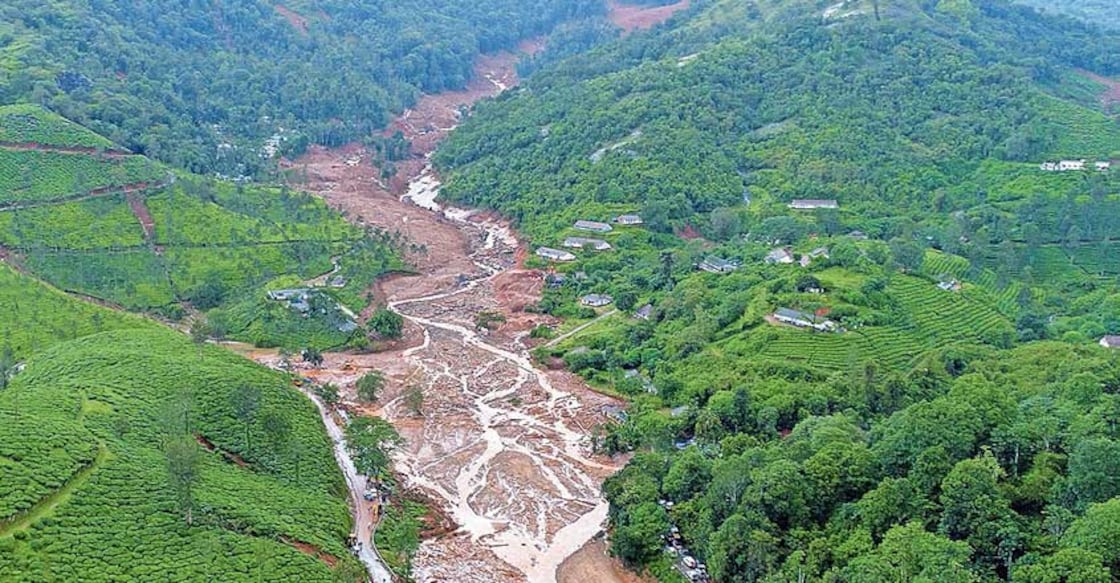Kavalappara and Puthumala testimonies to dangers lurking in Kerala's high ranges

Mail This Article
Except for the monotonous grumble of excavators, an eerie silence pervades Kavalappara and Puthumala, the hilly villages that turned into mass graves after a bout of devastating landslides along the high ranges of Kerala. Even as rescue missions search for any trace of the missing persons, geologists have started hunting for clues to explain nature’s fury.
Dr V Nandakumar from the National Centre for Earth Science Studies (NCESS) and Dr P R Arun from the Centre for Water Resources Development and Management (CWRDM) led a team to the ground zero in Malappuram and Wayanad districts to examine the ravaged areas for Manorama.
Kavalappara and Puthumala are struggling to overcome the trauma of the natural disaster that buried entire settlements in a flash in the evening of August 8. Survivors of the tragedy are still in shock. They do not know if they will ever see some of their relatives. Both villages are swarming with police, firemen, government officers, people’s representatives and volunteers. Aid pours in from across Kerala and even outside the state.
At least 46 people perished in Kavalappara near Pothukal in Malappuram district when the Muthappan Hill caved in around 7:30pm on August 8. Thirteen people are yet to be traced. The area recorded heavy rainfall for a week until the tragedy. Nilambur recorded 66 per cent more than the average rainfall between August 1 and 7. The rainfall gauged at Nilambur was 189.4 millimetre, compared with an average of 114 mm.
The landslide at Kavalappara started on the northern slope of the 350m high Muthappan hill. A mud block of 2m snowballed from a height of 275m, taking with it loose soil and rocks.

The hill was home to two streams, according to topographic sheets from a 1972 survey. Both streams have been filled up completely up to 100m from the valley. The streams were a natural drain to collect all excess rain water out of the hill. Once they were blocked, water was trapped.
Compounding the threat was the mechanised tampering of the terrain for rubber cultivation. The pits dug for the plantation changed the soil structure. Water flooded in the pits gradually sifted through the surface. This area has top soil for only 2m. The soil is held together to the rocky layers beneath by lithomargic clay. A steady percolation of water diluted the clay and washed it away, weakening the link between the rocky base and the top soil.
Soil and mud are usually washed away to the valley through streams. Once the streams were gone, the debris went downhill in whichever path it found. This slide would take everything along its way, including soil soaked in rain, boulders let loose and even uprooted trees. The debris that deposited near the Kavalappara canal reveals the extent of the tragedy.

An examination of the crown of the slide (the point where the slide started), the eroded surface and the toe area (the final destination of the debris) makes it clear that the tragedy was caused by unscientific changes to the soil structure. An area flanked by two remaining streams survived the landslide unscathed.
At Puthumala near Meppadi in Wayanad district, the landslide killed 11 people. Six people are yet to be found. The 1,300-m-high Thollayiram hill slid to the valley around 4 pm on August 8. The crown of the slide was identified at the eastern slope of the hill. The area received about 550 mm rain for three days up to August 7. Though the landslide started minimally, the structure of the terrain aggravated the descent. Even areas 4 km downhill were affected. The death toll went up thanks to unscientific construction at several places in the valley.

A stream that ran from the top of the hill to the valley had been filled up. This could be the result of an earlier landslide or deliberate efforts by the people. The area had been built up. The present generation of residents may not even know of the existence of a stream in the area.
Puthumala has experienced landslides in the previous years. Many of the slopes were slid in last year’s heavy rain as well. Even this year, smaller landslides were reported before August 8.
The Puthumala landslide was different from that of Kavalappara. The Puthumala landslide started out as one of those smaller landslides that occur deep inside the forest. However, the landslide turned deadly because the soil structure in the lower parts was fragile and soaked in rain. When rocks and soil crumbled under pressure, it turned into a huge landslide. Large-scale deforestation in the hill made sure that no trees were left to stop the deadly slide. Kilometres of valley were buried under logs and rocks and soil.
Scientists point to three major reasons for recurring landslides. Unscientific construction and mining on the hill change the structure of the soil. When the streams are blocked the water percolates to the deeper layers and changes the soil structure. The third problem is related to a change in the pattern of rainfall. Heavy downpours occur in short intervals. This has turned Kerala’s high range vulnerable to landslides.


